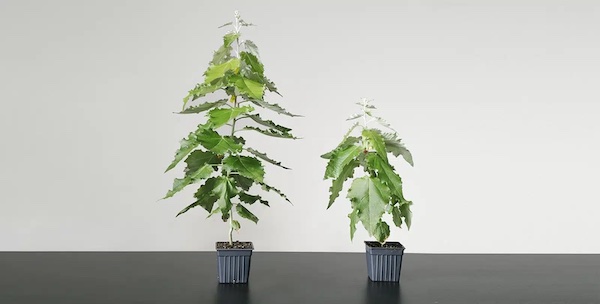When it comes to capturing carbon in the atmosphere, few things in this world are more efficient – let alone “green” – than trees. A biotechnology firm called “Living Carbon” believes that supercharging trees to grow faster and store more carbon could be a powerful nature-based solution to reducing CO2 levels.
As most likely recall from basic biology class, trees naturally absorb CO2 through the process of photosynthesis. Leaves pull in carbon dioxide and water and use the energy of the sun to convert this into chemical compounds such as sugars that feed the tree. The trees then release a by-product of that chemical reaction which is literally the air that we breath – oxygen.
As they grow, trees also store carbon dioxide in their fibers (trunks, branches, roots) for decades, or even centuries. According to the Arbor Day Foundation, in one year a mature tree will absorb more than 48 pounds of carbon dioxide from the atmosphere. Not surprisingly, planting more trees has long been one of the proposed solutions to naturally removing more carbon from the atmosphere.
Living Carbon is using genetic engineering to turbocharge the natural superpowers of trees. The company claims its “photosynthesis-enhanced trees” grow up to 50% faster and absorb up to 27% more CO2 than typical trees. “That means more timber, forests, and other carbon-storing products sooner and cheaper,” according to Chris Sacca, founder of Lowercarbon Capital. Sacca’s company participated in Living Carbon’s recent $36 million funding round along with Temasek, Toyota Ventures, and other angel investors.
Living Carbon’s “super trees” are a poplar-aspen hybrid engineered to make photosynthesis more efficient. The company’s researchers inserted genes from pumpkin and green algae that allow quicker growth and better carbon storage by lowering the rate of a process called photorespiration – which wastes energy and allows fixed carbon to re-enter the atmosphere as CO2.
The firm sells its biotech tree seedlings to landowners, which can then sell credits to organizations that want to offset their CO2 emissions. Landowners can also utilize Living Carbon’s monitoring and quantification system. Living Carbon’s current trials include over 600 photosynthesis-enhanced trees as part of a four-year partnership with Oregon State University (OSU). The firm also claims over 3,000 acres of carbon projects secured with private landowners across the Southeast and Appalachia.
The company intends to use its new funding to supply 4-5 million seedlings throughout the US in 2023-2024. Part of that effort will begin in February with 60,000 seedlings and Living Carbon has already sold out the carbon credits for them for 2023. They’re currently conducting pre-sales for the next two years.
Living Carbon is a non-profit organization founded in 2019 with a stated mission of “responsibly balancing the planet’s carbon cycle through the inherent power of plants.” The company is also working on a trait that will allow trees to store more metals naturally in their roots, lengthen the time that carbon is stored there, produce more durable wood products, and clean up toxic soils. With funding from Frontier Climate, the company is also engaged in cutting-edge research and development that aims to create long-lasting biopolymers that can store carbon for millennia. Learn more at Living Carbon’s website HERE . (Sources: AgFunder, Discovery, CarbonCredits)







